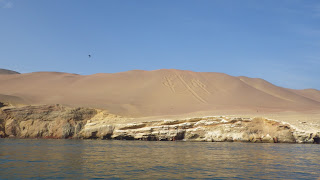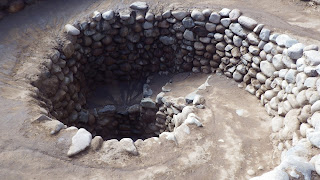“Era hermoso Paracas; tenía desierto, de oasis, de
balneario; arena, palmeras, flores, veredas y caminos por donde chicas que yo
no me atrevía a mirar, pocas ya, las últimas, las más atrasadas, se iban
perezosas a dormir esa siesta de quien ya se acostumbró al hotel de lujo. Tímidos y curiosos, mi padre y yo entramos al
comedor.”
-Alfredo Bryce Echenique “Con Jimmy en Paracas” Cuentos Completos
“Water,
water, water....There is no shortage of water in the desert but exactly the
right amount , a perfect ratio of water to rock, water to sand, insuring that
wide free open, generous spacing among plants and animals, homes and towns and
cities, which makes the arid West so different from any other part of the
nation. There is no lack of water here unless you try to establish a city where
no city should be.”
-Edward
Abbey Desert Solitaire: A Season in the
Wilderness
Spending time with my grandmother is an experience. This past weekends adventure to Paracas,
Huachachina, and Nasca (three destinations in the province of Ica) was no
exception. We left our hotel at
approximately balls o’clock Friday morning (4:30 am) and traveled south along
the Pan-American Highway, which according to the Guinness Book of World Records
happens to be the world’s longest motorable road.
Our journey began in Paracas. Now a major international tourist
destination, Paracas was once the weekend retreat of the limeño elite. In one of my classes we read a short story by
Alfredo Bryce Echenique entitled, “Con Jimmy en Paracas”; the story unfolds in Hotel
Paracas, a luxury resort, and deals with class and race relations. Naturally, I was curious about the Hotel
Paracas, and mentioned to our guide that I would like to see the place (yes we
had a guide, when you travel with grandma you travel in style, at least
relatively speaking). I was picturing a
quick stop by the front gate, but Oscar had something else in mind. He told me that they would never let him into
the hotel, but that if I pretended that I wanted to book a bungalow we could
probably get a private tour. I knew that
this would give Oscar the unprecedented opportunity to see inside the world of
the one percent, and I wanted to give my acting skills in Spanish a try.
Well, the three of us walked into that resort like we owned the
place. Never mind that I was wearing a
pair of jeans that were starting to rip in the crotch (Well, what do you
expect? I only brought two pairs of
pants with me) and a Bowdoin sweatshirt that had seen better days; we were
going to see the Hotel Paracas. The sad
truth is that sometimes being white can be a valuable means of gaining access to the exclusive.
Sometimes it means that you are dressed for the occasion, even if its
formal and your clothes are not; sometimes it means that you are beautiful, even if you might feel differently; and sometimes it means that you are wealthy, even if you are just a broke college student who works in a dining hall to make ends meet.
I marched right up the front desk and explained that my
friends and I from Católica (shameless name dropping) were thinking about
booking a room in a resort to relax after finals, and I wanted to see the rooms
before we made a final decision. The
staff didn’t even pause, and an impeccably dressed young man materialized to
show us the grounds. The interior of the
bungalow was ultramodern and simple-a harmonious mix of calming colors and
bamboo facades; the gardens were impeccably manicured; and the infinity pool
was an aquamarine oasis-you could even pay to rent a private sitting room
nearby, imagine that. And no luxury
hotel would be complete without the obligatory collection of artifacts from a local indigenous population. So it didn't really surprise me to find a small collection of authentic Nasca ceramics displayed in glass cases by the gift shop.
Just a taste of paradise...
Back in the car, Oscar and I burst into nervous
laughter. But I couldn’t help but
feeling a little bit sick. In this
enclave in the desert, the difference between the haves and the have nots came sharply into focus.
Later, we wandered through the Paracas National
Reserve-Peru’s oldest marine reserve. Of
the park’s 335,000 ha about 60% are comprised of marine waters, but the reserve includes a tropical desert and preserves various archaeological sites, as
well. In other words (excuse my French)
it’s really fucking cool! On the edge of
the park there is a small, but informative and well organized, interpretation
center that provides information about the area's geology and biology. The museum has a strong focus on
environmental consevation. In 1998, Peru
was identified by Conservation International as one of 17 megadiverse countries
in the world, and Peru will be one of the top 3 countries affected by climate
change. In other words, my adopted home
has pretty high stakes in the important problem facing society today.
Before the earthquake of 2007 this was an arch and the symbol of the reserve
Blustery and beautiful
Just horsing around
On our way to our hotel we stopped in Ica to tour a vineyard and sample Pisco. That night we stayed in Huachachina, a small village geared
at tourism, located around a desert oasis with reputed medical properties
outside of the city of Ica. All I can
say, is move over Cusqueños, you have a lot to learn from los bricheros
huachineros. The men in this town were
truly shameless; I mean, who hits on a girl traveling with her grandmother,
seriously.
Pisco on pisco on pisco
A small sample of local liquors...
Desert oasis
The next morning we returned to Paracas for a boat tour of las Islas Ballestas, also known as the mini-Galapagos Islands of Peru. Thanks to the nutrient rich water of the Humboldt Current, las Islas Ballestas are home to a plentitude of wildlife: namely birds (including Peruvian boobies, penguins, and tendrils) as well as seals and sea lions. The tour lasts about 2 hours and includes, in addition to wildlife sitings, a view of the a geoglyph and the guano operations on the island.
Candelabra? Navigation Device? Cactus?
Didn't get a picture of the porpoises but I got a picture of people taking a picture of the porpoises
Alfred Hitchcock anyone?
Small scale fishing using traditional techniques is allowed in the reserve
Rocks and bird shit
The desert
Two lonely adventurers
Wind sculpted sand scape
Lista? Sí!
Sunset behind our dune buggy
Lawrence of Arabia?
Better then sledding-its not cold!
Flight cast and crew; representing: US, Peru, Portugal, and Ireland
View from the bottom of the well
Infinity
The Cantalloc aqueduct






























No comments:
Post a Comment